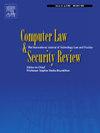Deepfake detection in generative AI: A legal framework proposal to protect human rights
IF 3.3
3区 社会学
Q1 LAW
引用次数: 0
Abstract
Deepfakes, exploited for financial fraud, political misinformation, non-consensual imagery, and targeted harassment, represent a rapidly evolving threat to global information integrity, demanding immediate and coordinated intervention. This research undertakes technical and comparative legal analyses of deepfake detection methods. It examines key mitigation strategies—including AI-powered detection, provenance tracking, and watermarking—highlighting the pivotal role of the Coalition for Content Provenance and Authenticity (C2PA) in establishing media authentication standards. The study investigates deepfakes' complex intersections with the admissibility of legal evidence, non-discrimination, data protection, freedom of expression, and copyright, questioning whether existing legal frameworks adequately balance advances in detection technologies with the protection of individual rights. As national strategies become increasingly vital amid geopolitical realities and fragmented global governance, the research advocates for a unified international approach grounded in UN Resolution 78/265 on safe, secure, and trustworthy AI. It calls for a collaborative framework that prioritizes interoperable technical standards and harmonized regulations. The paper critiques legal frameworks in the EU, US, UK, and China—jurisdictions selected for their global digital influence and divergent regulatory philosophies—and recommends developing robust, accessible, adaptable, and internationally interoperable tools to address evidentiary reliability, privacy, freedom of expression, copyright, and algorithmic bias. Specifically, it proposes enhanced technical standards; regulatory frameworks that support the adoption of explainable AI (XAI) and C2PA; and strengthened cross-sector collaboration to foster a trustworthy deepfake ecosystem.
生成人工智能中的深度假检测:保护人权的法律框架建议
深度造假被用于金融欺诈、政治错误信息、未经同意的图像和有针对性的骚扰,对全球信息完整性构成了迅速演变的威胁,需要立即进行协调的干预。本研究对深度伪造检测方法进行了技术和比较法律分析。它研究了关键的缓解策略,包括人工智能检测、来源跟踪和水印,强调了内容来源和真实性联盟(C2PA)在建立媒体身份验证标准方面的关键作用。该研究调查了深度造假与法律证据的可采性、非歧视、数据保护、言论自由和版权的复杂交集,质疑现有法律框架是否充分平衡了检测技术的进步与个人权利的保护。在地缘政治现实和全球治理碎片化的背景下,国家战略变得越来越重要,该研究倡导以联合国关于安全、可靠和值得信赖的人工智能的第78/265号决议为基础,采取统一的国际方法。它要求建立一个协作框架,优先考虑可互操作的技术标准和协调的法规。本文对欧盟、美国、英国和中国的法律框架进行了批评,这些国家因其全球数字影响力和不同的监管理念而被选择,并建议开发强大的、可访问的、适应性强的、国际互操作的工具,以解决证据可靠性、隐私、言论自由、版权和算法偏见等问题。具体而言,它提出了增强的技术标准;支持采用可解释人工智能(XAI)和C2PA的监管框架;加强跨领域合作,打造可信赖的深度造假生态圈。
本文章由计算机程序翻译,如有差异,请以英文原文为准。
求助全文
约1分钟内获得全文
求助全文
来源期刊
CiteScore
5.60
自引率
10.30%
发文量
81
审稿时长
67 days
期刊介绍:
CLSR publishes refereed academic and practitioner papers on topics such as Web 2.0, IT security, Identity management, ID cards, RFID, interference with privacy, Internet law, telecoms regulation, online broadcasting, intellectual property, software law, e-commerce, outsourcing, data protection, EU policy, freedom of information, computer security and many other topics. In addition it provides a regular update on European Union developments, national news from more than 20 jurisdictions in both Europe and the Pacific Rim. It is looking for papers within the subject area that display good quality legal analysis and new lines of legal thought or policy development that go beyond mere description of the subject area, however accurate that may be.

 求助内容:
求助内容: 应助结果提醒方式:
应助结果提醒方式:


